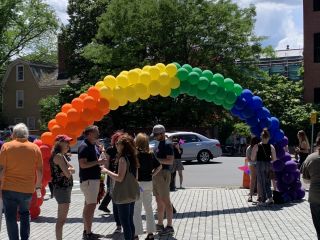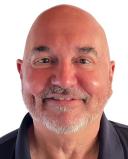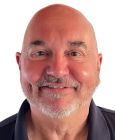Sexual Orientation
Pride Comes From Choosing to Embrace Your Truth
Personal Perspective: Self-acceptance is the foundation of authenticity.
Posted June 13, 2024 Reviewed by Ray Parker
Key points
- Choosing to accept or resist your truth leads either to pride or shame.
- Pride arises from identifying with and honoring your community's charitable efforts.
- A life-altering medical diagnosis "means" only what you choose to let it mean.

I marched in my first Pride parade in Boston way back in 1982. I’m embarrassed to recall my prissy, preppy parade attire: a pink button-down shirt, bow tie, and navy blazer.
But I also recall the new sense of personal liberation I felt that June day, only months after “coming out” by finally choosing to accept—and no longer resist or hide—the fact I am a gay man.
A visit to Provincetown, Mass., in August 1981 marked a “before and after” as I gave up the closet for the brilliant light of day. Before that visit, I flirted with men and with the idea of being “out.” In “P-town,” I observed men walking hand-in-hand, dancing together, laughing, and simply enjoying the special town at the tip of Cape Cod. I described this visit in my book Stonewall Strong as the first time I ever felt “normal.”
One year after graduating from an evangelical college—where I shared what I called my “secret” with just a couple of close friends because being gay could get you kicked out of school—I finally chose honesty, integrity, openness, and wholeness.
Finding Pride in the LGBTQ Community
“Pride” came to have a variety of meanings for me over the years. One of the strongest tributaries to my sense of pride as a gay man was the extraordinary heroism I witnessed and chronicled as gay men, lesbians, and the family members and friends who stood with us rose up to meet the multitude of challenges the HIV pandemic brought upon us.
In choosing to pursue a writing career, I also chose to follow the ancient dictum to “write what you know.” In my case, I wrote about gay life as I learned about it. Soon enough, I would focus, in particular, on writing about HIV-AIDS because it was devastating my community and, by the time I was in journalism school in 1985, beginning to kill my friends.
I wrote for LGBTQ and mainstream media about the amazing level of volunteerism in our community. Men and women provided companionship as “AIDS buddies,” helped with grocery shopping and transportation, and offered friendship to people with AIDS who too often were rejected by their own families.
I wrote about the terrible losses we sustained and the trauma that gripped our hearts as we witnessed our loved ones face terrible illness and premature death.
And I wrote about the changes within the field of medical research and the very definition of what it means to be a “patient.” These changes came about because gay men rejected the stigma too many expected them to bear—simply for being “different,” let alone for having the misfortune of contracting a deadly illness that too many considered shameful.
Another “Before and After,” Another Choice
When I experienced another "before and after"—before and after a phone call from my doctor on October 27, 2005—I had to make another choice: I had to decide what living with HIV was going to mean and look like for myself.
I knew I would do my best to adhere to my medical treatment because, well, I wanted to live. I also knew I didn’t want my new HIV-positive status to define me. I wasn’t willing to reduce all that I am to a medical diagnosis—least of all to one that carries all that freight.
That’s why I looked to the first gay men to be diagnosed with HIV back in the early 1980s—men like Bobbi Campbell, a San Francisco nurse, who became the first person ever to go public with his AIDS diagnosis. Campbell was one of the men who met together in Denver in 1983 and crafted the so-called “Denver Principles.”
These guidelines for living with and caring for those living with HIV-AIDS rejected any kind of victim label. They insisted those with the virus be known as “people with AIDS.” Their humanity, their personhood, was what mattered most; their medical diagnosis was secondary.
Something I "Have”—Not Who I Am
Just as I learned by embracing my truth about what place my sexual identity would occupy among my various identities—among them, son, brother, uncle, coworker, New England native, and writer—I had to learn by living with it what living with HIV would mean for me.
It most certainly means seeing my primary doctor more often than most people do for lab work and, for the last couple of years, testosterone replacement therapy (“low T” affects HIV-positive men beyond its natural diminishment connected to aging).
It means taking a big pill every day, as well as smaller pills for cholesterol, blood pressure, and uric acid—which may be related to HIV or simply be due to my age, or both.
It means that every choice I make to travel or move has to account for making sure I can continue to get my life-saving medication.
And it means I feel a deep empathy for others who also live with a life-altering health condition. This makes for deeply personal connections with people I may not know well yet feel close to because I know they know the hard, vulnerable side of being human.
Pride has become a nuanced idea as I’ve gotten older. But one thing that hasn’t changed for me is this: I remain proud that I made the choice, after visiting Provincetown way back in 1981, to embrace my liberation. I chose to define my life—including what it means to me to be gay and to live with HIV—on my own terms, not on anyone else’s.
I chose pride over shame. I chose resilience over self-destruction. I chose authenticity over duplicity. And that, as Robert Frost famously wrote about choosing the lesser-traveled of two roads in the woods, has made all the difference.




